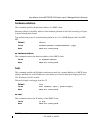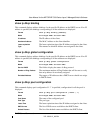
User Manual for the NETGEAR 7300 Series Layer 3 Managed Switch Software
FSM7326P Power Over Ethernet Commands 13-1
202-10009-01_060204
Chapter 13
FSM7326P Power Over Ethernet Commands
This chapter provides information on the Power Over Ethernet Commands available in the
FSM7326P Switch software.
The IEEE 802.3 Ethernet standard body has a task force called the 802.3af, which specifies the
method to deliver power over the LAN. 802.3af, also known as Power over Ethernet, defines a
way to build Ethernet power-sourcing equipment and powered terminals. The specification
involves delivering 48 volts of AC power over unshielded twisted-pair (UTP/FTP) wiring.
Power over Ethernet (PoE) is a technology that can integrate data, voice and power on a LAN. PoE
supplies reliable, uninterrupted power to Internet Protocol (IP) telephones, wireless LAN access
points, and other Ethernet devices that use existing Cat5 cables.
Power over Ethernet, when used in conjunction with an uninterrupted power supply (UPS),
ensures continuous operation during power failures. PoE saves time and eliminates the cost of
installing separate power cabling and AC outlets.
The power delivered over the Ethernet cabling is automatically activated when a compatible
device is identified. The power is injected by either new generation Ethernet switches (end-Span)
or by a dedicated patch-panel like device, residing between an ordinary Ethernet switch or hub and
the terminals (mid-span). Mid-span devices are available with 1,6,12 or 24 ports. PoE technology
does not degrade the network data communication performance or decrease the network reach.
Wireless Access points often need to be located in high places, like the ceiling, where the
necessary power lines and data access are not readily available. An integrated power-data network
solves that problem and allows greater flexibility and range in wireless networking.
In order for the network to carry power, you need to add power sourcing equipment (PSE). This is
the source of power and the means to integrate that power onto the network. The PSE also
provides a detection method for determining whether the Ethernet device on the other end of the
cable, the Powered Device (PD), is 802.3af compliant or not.
Most vendors today implement the PSE technology outside of the existing switch, a technique
called a midspan solution. AVAYA and Cisco also implement this technology inside the switch,
called an end-span solution.


















